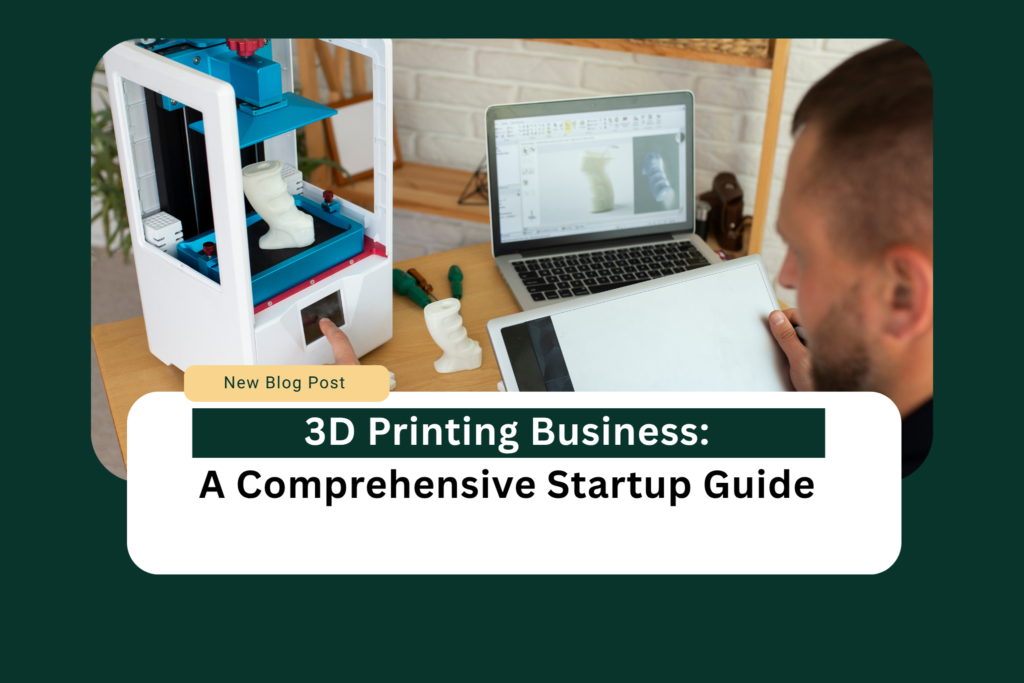Introduction
The 3D printing industry has transformed dramatically in recent years, evolving from a specialized technological novelty into a thriving entrepreneurial landscape. Business leaders entering this space encounter a fertile environment where innovative additive manufacturing solutions serve diverse market sectors.
Launching a 3D printing venture creates opportunities for creative professionals, strategic thinkers, and technology enthusiasts to build contemporary businesses addressing sophisticated manufacturing challenges. These enterprises can cater to multiple markets, from consumer products and healthcare to automotive and aerospace industries.
The sector’s rapid growth has created numerous business models, including on-demand manufacturing services, specialized product development, equipment sales, and material innovation. Entrepreneurs can leverage relatively low barriers to entry while capitalizing on the technology’s capacity to produce complex geometries impossible with traditional manufacturing. As adoption accelerates across industries, 3D printing continues to disrupt conventional production paradigms while opening new revenue streams for forward-thinking business owners who recognize its transformative potential.
Understanding the 3D Printing Market Landscape
The 3D printing market worldwide shows substantial growth potential because Grand View Research predicts it will reach $76.17 billion by 2030 at a compound annual growth rate of 21.0%. The fast-growing nature of the 3D printing market presents substantial entrepreneurial opportunities to those who dedicate their time and resources to building advanced business strategies. Entrepreneurs can choose from multiple market segments which include rapid prototyping alongside industrial manufacturing custom consumer products and medical device manufacturing.
Market Research and Competitive Analysis
A successful 3D printing business depends on conducting thorough market research at its foundation. Entrepreneurs need to thoroughly understand their future target markets which include aerospace, automotive, healthcare, and consumer goods industries. The evaluation of competitive markets enables businesses to detect their distinctive market offerings as well as unmet service needs. The analysis of current competitors allows new businesses to create unique specialized services which help them stand out in an expanding marketplace.
Essential Technical and Business Preparations
The creation of a 3D printing business demands substantial technical expertise combined with strategic planning. The foundation of starting a 3D printing business involves acquiring high-end equipment that costs from $5,000 to $100,000 based on printer sophistication. Business owners should thoroughly examine their target market requirements to choose printing technologies by assessing material compatibility print resolution and production speed needs.
Developing Technical Expertise
The 3D printing industry demands continuous learning as a fundamental factor for reaching success. Professionals in this field need to maintain active knowledge regarding fast-changing technology developments materials and printing methods. Entrepreneurs who participate in industry conferences and online forums alongside certification programs will maintain their competitive advantage in the market. The establishment of strong connections with equipment manufacturers and material suppliers allows entrepreneurs to gain valuable insights and potential strategic partnerships.
Financial Planning and Investment Strategies
The establishment of a 3D printing business strongly depends on financial planning as its essential foundation. The PwC research indicates that startup costs for small manufacturing businesses extend from $50,000 to $250,000 for acquiring equipment and workspace and operational expenses. A business plan needs to contain thorough financial forecasts alongside revenue prediction models and operational expense management techniques which entrepreneurs must create.
Diversifying Revenue Streams
To maintain financial stability 3d Printing Business Startup need to develop various revenue streams. The business offers prototype development alongside custom manufacturing services, design consulting and educational workshops to its clients. Entrepreneurs who expand their service range establish business structures that resist industry shifts and technological advancements.
Marketing and Client Acquisition Strategies
The 3D printing industry requires successful marketing to gain clients while building market credibility. Businesses that develop a strong digital presence by using professional websites targeted social media campaigns and industry-specific networking platforms can reach potential customers. The 3D printing business stands out in competitive markets through displaying past achievements, technical expertise and distinctive problem-solving methods.
Building Strategic Partnerships
The creation of strategic partnerships together with networking activities leads to rapid business expansion. The 3D printing business can benefit from partnerships with design firms, engineering companies, manufacturers and industry associations through which they can gain referrals and collaborative projects. Entrepreneurs who join trade shows and attend industry conferences and professional organizations develop expanded professional networks.
Legal and Regulatory Considerations
A 3d Printing Business Startup requires a proper understanding of legal and regulatory requirements to establish legitimacy and compliance. All entrepreneurs need to learn about intellectual property regulations as well as secure required business permits while following industry-specific rules. During startup, the business needs professional advice from legal experts who understand manufacturing and technological sectors.
Intellectual Property Protection
Intellectual property protection stands as a vital issue throughout the entire 3D printing business domain. Business owners who create protective strategies for design ownership and patent applications together with trademark documentation will protect their innovative work from legal challenges. Business owners need to collaborate with IP attorneys for thorough protection system planning.
Conclusion: Embracing Innovation and Opportunity
Through technological investments specialized expertise and distinctive value creation entrepreneurs gain terrific business prospects in the 3D printing market. Business owners who invest their expertise in planning together with ongoing education efforts develop successful enterprises that advance technology while resolving complicated manufacturing problems.
We welcome your insights regarding the start of a 3D printing business.
Have you contemplated entering the promising business sector that represents this lucrative industry? We welcome your input containing personal views, feedback or concerns you have through the comments section. Please spread this guide across your social media profiles to support other business owners interested in exploring this modern business venture.
FAQ
What amount of capital does a 3D printing business need to initiate? A new 3d Printing Business Startup requires starting capital between $20,000 and $100,000 depending on the quality of equipment and workspace and specialized printing technologies.
Which sectors show the strongest interest in acquiring 3D printing services? The most profitable 3D printing service opportunities exist in the aerospace, automotive, healthcare, architecture, and product design industries.
Will my business succeed without formal education in engineering or design? The business credibility and service quality level of a 3D printing service increases dramatically when the operator has technical expertise in computer-aided design (CAD) and manufacturing processes although it is not a requirement.
What certifications can improve my 3D printing business credibility? Consider obtaining certifications from organizations like ASME, SME (Society of Manufacturing Engineers), or specific 3D printing technology providers.
Read More : Craft brewery and distillery business strategy








